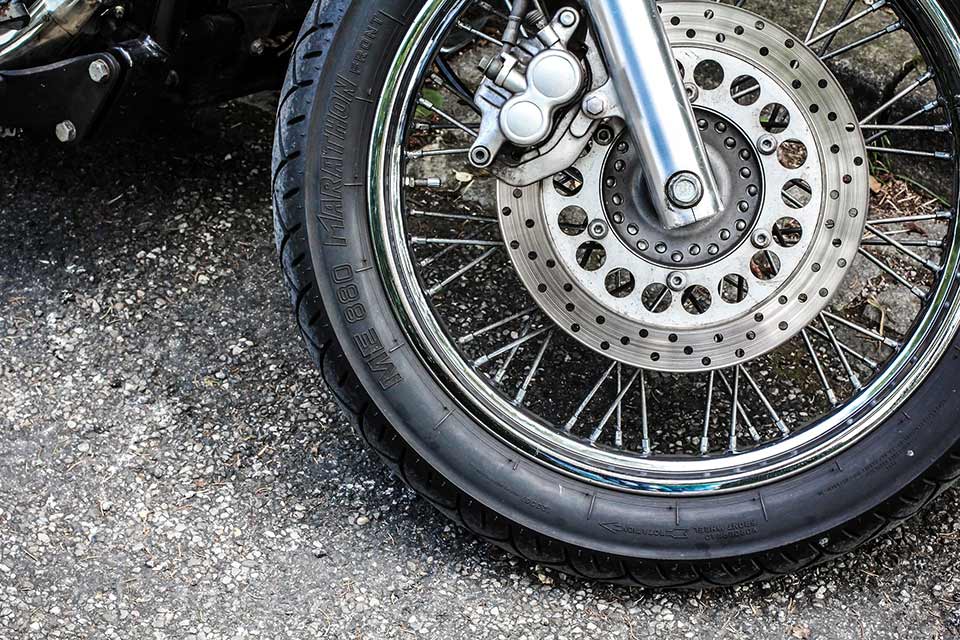There’s few things worse than realising you have a flat tyre. Maybe it’s just my luck, but I always seem to get them at the worst possible time. Not only did a flat tyre once make me late to my first day at a new job, but even worse, a flat tyre was the reason I missed the first half of a wedding!
How will I know if I have a flat tyre on a motorcycle?
Even if you are the safest rider to grace the planet, it’s more than likely that you will experience a flat tyre at some point in your riding career. If your bike starts to lightly shake, or it feels like you are losing power, it’s probable that one of your tyres have deflated. You might not know how it was caused or exactly when it happened, but possible causes are riding through a pothole or by driving over a loose nail which has then penetrated the tyre.
Should I continue to ride on a flat tyre on a motorcycle?
No, absolutely not. Riding on a flat tyre restricts the amount of control you have on the bike and can cause permanent damage to the rim of the wheel. Inflated tyres protect and act as a cushion to the rim, so a flat tyre therefore offers little protection. Once you know you have a flat tyre, you should pull onto the side of the road by following these steps –
- Gently roll off the throttle.
- Avoid any sudden and sharp changes in direction.
- Gently apply the brake of the wheel that isn’t flat (if you are unaware of which tyre is flat, gently apply both brakes) and slowly come to a halt.
Will I be able to repair the tyre immediately?
Unless you are a mechanic and have your tools with you, or you are carrying a ‘tyre repair kit’, it’s highly unlikely that you will be able to repair the tyre at the scene. However, as long as you have your mobile you will be fine. If you are near home, you could ring a friend or family member to come and bring you the necessary equipment, or if you are in the middle of nowhere, the best option is to call either your insurance company or a breakdown company. If you don’t have a phone or a repair kit, ask to borrow a member of the public’s phone. If you are really struggling, push the bike to the nearest place that you can borrow a phone – it’s not ideal, but it’s better than riding the bike.
What is the best way to prepare for a flat tyre?
As mentioned earlier, it’s near impossible to avoid getting a flat tyre, and they seem to always happen when you are least prepared. However, there are some precautions that you can take to reduce the chances of getting a flat tyre, and to prepare yourself for when it does happen.
- Regularly check the tyre pressure, tread levels and overall condition of the tyre – Riding when the pressure is low will gradually flatten the tyre, and can also lead to premature tyre wear. You should also be checking that the whole bike is in good condition as a flat tyre isn’t the only part of the bike that can go wrong. For example, a loose chain can be a nightmare when riding, so make sure your chain is set to the correct tension using a Chain Monkey.
- Carry a ‘tyre repair kit’ on your bike – If you have room to store it on your bike, it’s definitely worth having. It will only temporarily fix the flat tyre, but it should ensure that you are able to get to your destination or somewhere to get it fixed.
When should I replace my tyres on a motorcycle?
It’s impossible to accurately predict the exact lifespan of a tyre as it can be impacted by multiple factors, but they usually last around 5 years. How frequently the bike is used, how often the tyres are checked/maintained and the load of the bike are just a few influences that can affect a tyre’s life expectancy. We advise you are regularly checking the condition of your tyres so that you can spot any problems early. Things to look out for:
- Foreign objects (nails,screws)
- Check the air pressures
- Look for any signs of cracking
- Check that the tyres have a minimum tread depth of at least 1mm across the central ¾ of the tyre
- Check the tyre has no punctures
- Check for any other damage
Read more: Caring for your motorcycle tyres
Read more: 6 things to check on your motorcycle before riding

